
Columbus is a city in, and the county seat of, Bartholomew County, Indiana, United States. The population was 50,474 at the 2020 census. The city is known for its architectural significance, having commissioned noted works of modern architecture and public art since the mid-20th century; the annual program Exhibit Columbus celebrates this legacy. Located about 40 mi (64 km) south of Indianapolis, on the east fork of the White River, it is the state's 20th-largest city. It is the principal city of the Columbus, Indiana metropolitan statistical area, which encompasses all of Bartholomew County. Columbus is the birthplace of former Indiana Governor and former Vice President of the United States, Mike Pence.
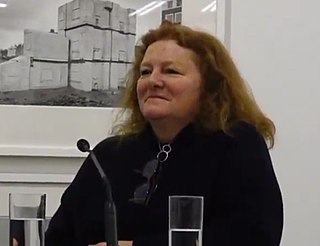
Dame Rachel Whiteread is an English artist who primarily produces sculptures, which typically take the form of casts. She was the first woman to win the annual Turner Prize in 1993.

Site-specific art is artwork created to exist in a certain place. Typically, the artist takes the location into account while planning and creating the artwork. Site-specific art is produced both by commercial artists, and independently, and can include some instances of work such as sculpture, stencil graffiti, rock balancing, and other art forms. Installations can be in urban areas, remote natural settings, or underwater.
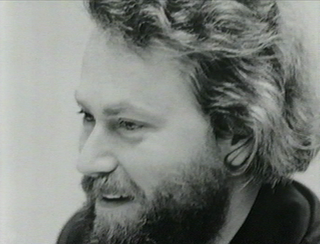
Donald Clarence Judd was an American artist associated with minimalism. In his work, Judd sought autonomy and clarity for the constructed object and the space created by it, ultimately achieving a rigorously democratic presentation without compositional hierarchy. He is generally considered the leading international exponent of "minimalism", and its most important theoretician through such writings as "Specific Objects" (1964). Judd voiced his unorthodox perception of minimalism in Arts Yearbook 8, where he says, "The new three dimensional work doesn't constitute a movement, school, or style. The common aspects are too general and too little common to define a movement. The differences are greater than the similarities."
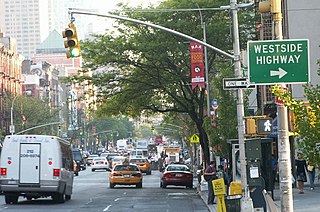
Ninth Avenue, known as Columbus Avenue between West 59th and 110th Streets, is a thoroughfare on the West Side of Manhattan in New York City, United States. Traffic runs downtown (southbound) from the Upper West Side to Chelsea. Two short sections of Ninth Avenue also exist in the Inwood neighborhood, carrying two-way traffic.
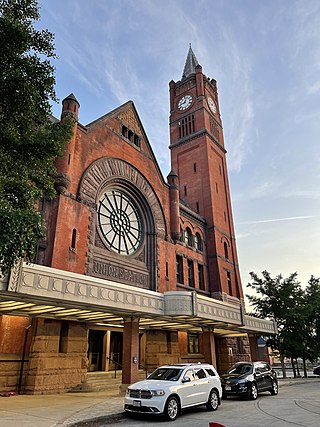
The Indianapolis Union Station is an intercity train station in the Wholesale District of Indianapolis, Indiana. Currently, Amtrak's Cardinal line serves the terminal, passing through Indianapolis three times a week each way.
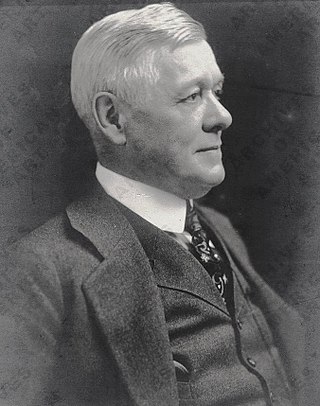
John Massey Rhind was a Scottish-American sculptor. Among Rhind's better known works is the marble statue of Dr. Crawford W. Long located in the National Statuary Hall Collection in Washington D.C. (1926).

Harrison West is a historic urban neighborhood located northwest of downtown Columbus, Ohio. It sits on several blocks along the Olentangy River and includes the western part of the Near Northside Historic District, which was placed on the National Register of Historic Places in 1975. The character of the neighborhood is similar to Victorian Village, which sits just to the east and is more well-known.

Chryssa Vardea-Mavromichali was a Greek American artist who worked in a wide variety of media. An American art pioneer in light art and luminist sculpture, known for her neon, steel, aluminum and acrylic glass installations, she always used the mononym Chryssa professionally. She worked from the mid-1950s in New York City studios and worked since 1992 in the studio she established in Neos Kosmos, Athens, Greece.
Craig A. Kraft is an American sculptor. Over the course of his career, Kraft has gained national recognition for his neon light works, establishing him as one of the leading neon sculptors of today. In his earlier works, such as Seated/Unseated Woman and Light Figure Fragment, Kraft rendered sculptures incorporating details in neon. Since 2000, the main focus of Kraft's art has been privately commissioned pieces, such as Connective Ascension, and monumental public art works, such as Lightweb in Downtown Silver Spring, MD, that are abstract pieces made from rolled aluminum and neon tubing.
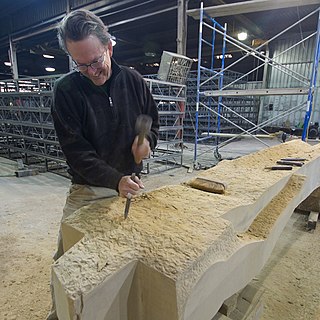
Richard Rhodes is an American sculptor, stonemason, entrepreneur, and scholar of stonework worldwide.

The statue of John Aaron Rawlins, a United States Army general who served during the Civil War and later as Secretary of War, is a focal point of Rawlins Park, a small public park in Washington, D.C.'s Foggy Bottom neighborhood. It was installed in 1874, but relocated several times between 1880 and 1931. The statue was sculpted by French-American artist Joseph A. Bailly, whose best known work is the statue of George Washington in front of Independence Hall in Philadelphia.

The Stephenson Grand Army of the Republic Memorial, also known as Dr. Benjamin F. Stephenson, is a public artwork in Washington, D.C. honoring Dr. Benjamin F. Stephenson, founder of the Grand Army of the Republic, a fraternal organization for Union veterans. The memorial is sited at Indiana Plaza, located at the intersection of 7th Street, Indiana Avenue, and Pennsylvania Avenue NW in the Penn Quarter neighborhood. The bronze figures were sculpted by J. Massey Rhind, a prominent 20th-century artist. Attendees at the 1909 dedication ceremony included President William Howard Taft, Senator William Warner, and hundreds of Union veterans.

Large Arch is an outdoor sculpture by British sculptor Henry Moore. It was installed in 1971 and is located in the outdoor plaza of the Cleo Rogers Memorial Library in Columbus, Indiana. Xenia and J. Irwin Miller commissioned the sculpture and gave it to the library. The sculpture is nearly 20 feet tall and is made of sandcast bronze that has been patinated.
Jill Sebastian is an American educational innovator, integrated public artist and multi-media artist.

David Black was an American sculptor known for both, his pioneering, avant-garde use of plastics and his monumental, aluminum, large scale public sculptures.
Cork Marcheschi is an American sculptor and musician, most notably recognized for his pioneering use of light in sculpture, his large body of public art work, and founding avant-garde psychedelic rock band Fifty Foot Hose. In the words of curator David Ryan, "Through art, music, writing, collecting and teaching, Cork Marcheschi saw the light early on — pursuing it in its many permutations — perfecting his artistry, a sculptural vision now widely admired."














